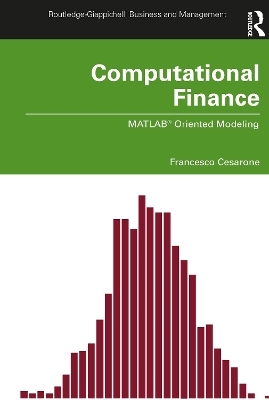
Computational Finance
Routledge (Verlag)
978-0-367-49293-9 (ISBN)
This book combines theoretical concepts with practical implementation. Furthermore, the numerical solution of models is exploited, both to enhance the understanding of some mathematical and statistical notions, and to acquire sound programming skills in MATLAB®, which is useful for several other programming languages also. The material assumes the reader has a relatively limited knowledge of mathematics, probability, and statistics. Hence, the book contains a short description of the fundamental tools needed to address the two main fields of quantitative finance: portfolio selection and derivatives pricing. Both fields are developed here, with a particular emphasis on portfolio selection, where the author includes an overview of recent approaches.
The book gradually takes the reader from a basic to medium level of expertise by using examples and exercises to simplify the understanding of complex models in finance, giving them the ability to place financial models in a computational setting. The book is ideal for courses focusing on quantitative finance, asset management, mathematical methods for economics and finance, investment banking, and corporate finance.
Francesco Cesarone is an Assistant Professor of Computational Finance at the Department of Business Studies of the Roma Tre University, Italy.
Part I Programming techniques for financial calculus
1 An introduction to MATLAB (R) with applications
1.1 MATLAB (R) basics
1.1.1 Preliminary elements
1.1.2 Vectors and matrices
1.1.3 Basic linear algebra operations
1.1.4 Element-by-element multiplication and division
1.1.5 Colon (:) operator
1.1.6 Predefined and user-defined functions
1.2 M-file: Scripts and Functions
1.3 Programming fundamentals
1.3.1 if, else, and elseif construct
1.3.2 for loops
1.3.3 while loops
1.4 MATLAB (R) graphics
1.5 Preliminary exercises on programming
1.6 Exercises on the basics of financial evaluation
1.6.1 Interest Rate Swap
Part II Portfolio selection
2 Preliminary elements in Probability Theory and Statistics
2.1 Basic concepts in probability
2.2 Random variables
2.3 Probability distributions
2.4 Continuous random variables
2.5 Higher-order moments and synthetic indices of a distribution
2.6 Some probability distributions
2.6.1 Uniform distribution
2.6.2 Normal distribution
2.6.3 Log-normal distribution
2.6.4 Chi-square distribution
2.6.5 Student-t distribution
3 Linear and Non-linear Programming
3.1 General Framework
3.2 Optimization with MATLAB (R)
3.2.1 Linear Programming
3.2.2 Quadratic Programming
3.2.3 Non-Linear Programming
3.3 Multi-objective optimization
3.3.1 Efficient solutions and the efficient frontier
4 Portfolio Optimization
4.1 Portfolio of equities: prices and returns
4.2 Risk-return analysis
4.2.1 Elements of Expected Utility Theory
4.2.2 General Framework
4.2.3 Mean-Variance model
4.2.4 Effects of diversification for an EW portfolio
4.2.5 Mean-Mean Absolute Deviation model
4.2.6 Mean-Maximum Loss model
4.2.7 Value-at-Risk
4.2.8 Mean-Conditional Value-at-Risk model
4.2.9 Mean-Gini model
4.3 Elements of bond portfolio immunization
Part III Derivatives pricing
5 Further elements on Probability Theory and Statistics
5.1 Introduction to Monte Carlo simulation
5.2 Stochastic processes
5.2.1 Brownian motion
5.2.2 Ito's Lemma
5.2.3 Geometric Brownian motion
6 Pricing of derivatives with an underlying security
6.1 Binomial model
6.1.1 A replicating portfolio of stocks and bonds
6.1.2 Calibration of the binomial model
6.1.3 Multi-period case
6.2 Black-Scholes model
6.2.1 Assumptions of the model
6.2.2 Pricing of a European call
6.2.3 Pricing equation for a call
6.2.4 Implied volatility
6.2.5 Black-Scholes formulas via integrals
6.3 Option Pricing via the Monte Carlo method
6.3.1 Path Dependent Derivatives
References
Suggested lesson plan
| Erscheinungsdatum | 06.08.2020 |
|---|---|
| Reihe/Serie | Routledge-Giappichelli Studies in Business and Management |
| Zusatzinfo | 59 Line drawings, black and white; 7 Tables, black and white; 59 Illustrations, black and white |
| Verlagsort | London |
| Sprache | englisch |
| Maße | 174 x 246 mm |
| Gewicht | 445 g |
| Themenwelt | Mathematik / Informatik ► Mathematik ► Angewandte Mathematik |
| Wirtschaft ► Betriebswirtschaft / Management ► Finanzierung | |
| Wirtschaft ► Volkswirtschaftslehre ► Ökonometrie | |
| ISBN-10 | 0-367-49293-8 / 0367492938 |
| ISBN-13 | 978-0-367-49293-9 / 9780367492939 |
| Zustand | Neuware |
| Informationen gemäß Produktsicherheitsverordnung (GPSR) | |
| Haben Sie eine Frage zum Produkt? |
aus dem Bereich


